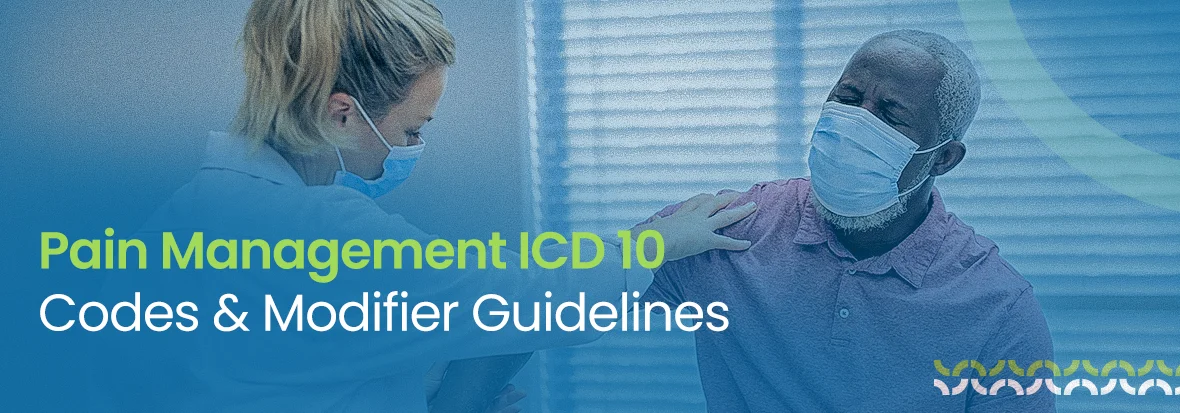Every missed detail in your chart creates risk for your pain clinic. Every ambiguous diagnosis causes confusion. Every misplaced modifier invites denials. These small mistakes often lead to claim rejections and delayed payments. They also raise the chance of costly audits and recoupments. On top of that, they create frustrating extra work for both clinicians and billing staff. Worse, they can result in unexpected bills for patients and even harm your clinic’s reputation with payers and referrers.
The good thing is that most of these hazards are avoidable. By following clear pain management ICD-10 codes and modifier guidelines, you can close many of the gaps. Focused note templates, strict documentation rules, and simple decision checkpoints can make the billing process reliable instead of risky.
The following guidelines deliver that solution: concise, practice-ready rules, examples you can paste into notes, and a short pre-billing checklist your team can use today to reduce denials, strengthen compliance, and protect both patients and your practice.
Start with the main reason for the visit (one-line rule)
Begin every note with one short sentence that says why the patient came in today. If the visit is for pain control, put the pain code first. If the visit is for another problem, put that problem first and pain second. This simple line helps coders and payers know the primary goal of the visit and avoids sequencing mistakes when you use the icd 10 code for pain control.
Pick the most specific pain code you can
Always use the most specific code the chart supports. Specific codes make it easier for payers to understand the problem and pay claims faster. For ongoing pain, use the G89 group (this is the set for icd 10 for chronic pain). For low back pain, select the correct M54 code, which is the ICD 10 code for low back pain. For sciatica, use a side-specific code like M54.31 (right) or M54.32 (left), which is the icd 10 code for sciatica. Only use R52 (pain, unspecified) temporarily when you truly do not have more detail.
If pain is new or long-term
Write how long the pain has lasted. This is an important part of your Documentation. If pain is new and started days ago, use an acute pain code. If pain has lasted weeks or months, use a chronic pain code from the G89 family. A short sentence like “Pain for 6 months — chronic” is enough to support your code choice.
What your note must show (must-have items)
Good notes prove your diagnosis and treatment. Before you sign the chart, make sure it has these items. Use bullets in the note so coders can find them quickly.
- Primary problem today: one short sentence (e.g., “Primary problem: left L5 radicular pain”).
- Location & laterality: exact spot and side (left/right/bilateral).
- Duration: how long the pain has been present (days, weeks, months).
- Exam findings: short points (e.g., “left SLR + at 40°, decreased left ankle reflex”).
- Procedure details: level, side, approach, medicines, and imaging used (if any).
- Medical decision making (MDM): why you chose the treatment and what alternatives you discussed.
- Separate E/M content: If billing an E/M the same day as a procedure, add a short extra HPI/exam/MDM to show the E/M was separate.
How to sequence codes (which goes first)
The first code on the claim tells payers the main reason for the visit. If you gave an injection or changed medicines for pain control, list the pain diagnosis first. If the visit was mainly for another problem (for example, infection), list that problem first and put pain as a secondary code. A short “Primary problem today” statement at the top of the note makes sequencing clear.
Modifier rules you must follow (simple and practical)
Modifiers explain why multiple services were done the same day. Use them only when your note clearly supports them. Below are the rules you need most.
Modifier 25 — E/M that is separate and important
Use modifier 25 in pain management when you perform a real E/M that is separate from the procedure on the same day. The note must show extra history, exam, or decision-making beyond routine pre-procedure steps. Add one short MDM sentence when you append modifier 25.
Modifier 59 — distinct procedural service
Use modifier 59 to show that two procedures were distinct and not normally billed together, only when no X modifier fits. Do not use 59 as a shortcut.
X modifiers — XE, XS, XP, XU (prefer these when they fit)
CMS and many payers prefer specific X modifiers over 59 when the facts match:
- XE = separate encounter.
- XS = separate structure.
- XP = separate practitioner.
- XU = unusual, non-overlapping service.
Difference between modifier 59 and XU: Modifier 59 simply says the procedures were distinct. XU says explicitly that the service was unusual and did not overlap with the other service’s usual parts. Use an X modifier when it best describes why services are separate; use 59 only if none of the X modifiers apply.
Other useful modifiers
- RT / LT — mark right or left for unilateral services.
- 50 — bilateral procedures (both sides).
- 76 / 77 — repeat procedures by the same provider (76) or a different provider (77).
Common ICD-10 errors and quick fixes
Many denials stem from a few recurring errors. Check for these simple errors before you submit a claim.
- Using R52 for too long
Fix: change to a specific code (M54 family or G89) when you have an exam or imaging. - Missing laterality
Fix: require RT/LT in the note template. - Wrong sequencing
Fix: Use the “Primary problem today” line to guide coders. - Misusing modifier 59
Fix: check XE/XS/XP/XU first and document why services are distinct. - Billing E/M with 25 without a separate MDM
Fix: add a short MDM bullet when billing E/M and a procedure the same day.
Two copy-ready examples to paste into your notes
Use these short templates in your chart to support ICD 10 for pain management and modifiers.
Example 1 — Pain control visit with injection
Primary problem: right sciatica x 3 months.
Exam: right SLR + at 30°, decreased right ankle reflex.
Plan: fluoro-guided right L5–S1 transforaminal epidural steroid injection.
Pre-procedure E/M: interval history, focused neuro exam, and decision to proceed.
Coding Tip:
Sequence M54.31 (sciatica, right) first. Add modifier 25 to the E/M only if the MDM shows the E/M was separate.
Example 2 — Two different procedures same day
Procedure 1: left gluteal trigger point injection for myofascial pain.
Procedure 2: left L5–S1 transforaminal steroid injection for radicular pain.
Rationale: Two separate pain sources treated.
Coding Tip:
Use XS (separate structure) if the procedures target different structures. If no X modifier fits, use modifier 59 with the note attached.
Pre-billing checklist (use each time)
Before you send a claim, run through this short list:
- Did you pick the most specific pain management ICD 10 codes (G89, M54, M54.31/M54.32)?
- Is laterality recorded (RT / LT) where needed?
- Is the Primary problem present at the top of the note?
- If E/M + procedure same day: does the E/M have a separate HPI/exam/MDM for modifier 25?
- If multiple procedures: did you choose the best X modifier or modifier 59, and did you document why the services are distinct?
How these rules protect your clinic
Following clear ICD 10 codes and modifier rules protects your clinic in many real ways. First, cleaner coding and better Documentation make denials less likely. When you use the correct pain management ICD 10 codes and write short, exact notes that show the problem, the exam, and the treatment, the payer can see the medical need right away. That means fewer “request for information” letters and fewer rejected claims. Each denied claim that you avoid saves staff time and brings money into the clinic faster.
Faster payments are a direct result of fewer denials. If claims are coded with the correct icd 10 code for pain control and the notes prove the service, the payer usually pays without long delays. Faster cash flow enables your practice to pay staff, purchase supplies, and plan for growth. When claims clear quickly, your billing team spends less time reworking claims and more time on productive tasks like clean claim submission and patient calls.
Conclusion
Accurate coding and clear notes protect your pain clinic from denials, slow payments, and audits. Using the correct pain management ICD 10 codes, solid Documentation, and proper modifiers (for example, modifier 25, modifier 59, or the X modifiers like XU) helps claims clear faster and makes audits easier to defend. This short guide gives simple, practical rules you can use today.

